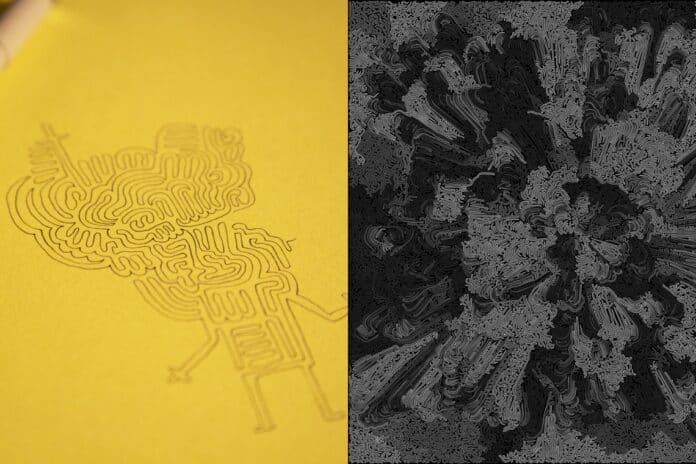Aleph-0, a creative fusion of Hackatao and Insigħt, has recently unveiled the convergence of art, mathematics, and quantum physics through NFTs.
Let’s see below all the details of this news.
Hackatao: a journey into the quantum art of NFTs
As anticipated, within the digital universe of NFTs, Aleph-0 {א0} emerges as an extraordinary fusion between the creative minds of Hackatao and Insigħt.
This union reveals the intriguing convergence between art, mathematics, nature, and the seductive mystique of quantum physics, offering a unique experience made possible thanks to NFT technology.
Specifically, the project embraces the infinite within clearly defined boundaries, giving life to a digital realm where a continuous line acts as a portal into the mysterious depths of the unconscious.
This line meanders on the canvas, revealing the subtle complexities of our perception and evoking the horror vacui often present in Hackatao’s work.
In other words, Aleph-0 is configured as a generative art project.
Since the early days of the crypto art scene, Hackatao has indeed noticed a deep connection between the blockchain and its potential application in generative art.
Not by chance, already in 2018 he had started experimenting with this type of artistic expression.
Aleph-0 therefore represents their first long-term generative art initiative, marking the genesis of a new platform that uses the Art Blocks Engine, on which they are already working on a second project.
A continuous line in the digital world: the NFT portal towards the unconscious and beyond
Exploring the boundaries of quantum physics, Aleph-0 becomes a manifestation of a qubit suspended in the ethereal dance of quantum superposition.
Users have the power to influence and collapse this cryptic quantum state, challenging the boundaries between the laws of quantum mechanics and the palpitation of human emotions.
In addition, the Insigħt dedicate their research to the application of quantum physics in generative art, a concept that resonates in Aleph-0, illuminating the cosmic unpredictability and the intertwined narrative of the human experience.
Reflecting on the words of Freeman Dyson, who suggests a subtle difference between matter observed in the laboratory and the mind perceived in consciousness, Aleph-0 goes beyond art.
It is configured as an enigmatic gateway to explore the unexplored territories of infinity, an open invitation to embrace the fabric of existence.
This constantly evolving collective work also features other individual works that are crossed by a meta-line, connecting them together. It is therefore a dynamic entity that promotes harmonious relationships among neighbors.
While exploring Aleph-0, the invitation is to embark on a thought experiment: take a pen, draw an uninterrupted line, and contemplate how it can become a visual representation of the unconscious or perhaps of an unknown cosmos.
New regulations for NFTs between Africa and Japan
The growing NFT market in Africa has recently raised key questions about the regulation of digital assets in countries like Kenya, Nigeria, and South Africa.
In the context of Kenya, for example, the Central Bank of Kenya (CBK) is considering significant changes to regulate digital currencies and NFTs, with the opportunity to introduce a Central Bank digital currency.
In Nigeria, on the other hand, a remarkable 10.34% of the population is involved in cryptocurrency trading, positioning the country at the 11th place globally for the adoption of cryptocurrencies.
While the legal frameworks in Nigeria address various aspects of digital resources, the convergence of enthusiasm for cryptocurrencies and emerging regulation outline complex challenges for NFT regulation.
Still, in South Africa, joint efforts between financial authorities aim at a structured regulatory framework for cryptocurrencies, with a focus on registration and anti-money laundering regulations.
South Africa’s intellectual property laws play a crucial role in protecting NFTs, but the specific application remains evolving.
In the same way, Japan also shows a remarkable commitment towards non-fungible tokens (NFTs), highlighting a significant shift in key sectors.
The boom of NFTs is linked to the rapid progress of blockchain technology in the country, ensuring secure and transparent transactions.
In fact, the timely adoption of blockchain has catalyzed the proliferation of NFTs in various sectors.
The expansion into the Japanese market highlights the importance of understanding the regulatory framework of NFTs, particularly in the context of the Financial Instruments and Exchange Act.
The current complexity of regulations in Japan, ranging from regulations on collective investments to laws on gambling, will likely adapt to the dynamism of NFTs.
A potential critical development could be the implementation of a system of non-action letters, aiming to clarify regulatory ambiguities and provide stability to the market.




